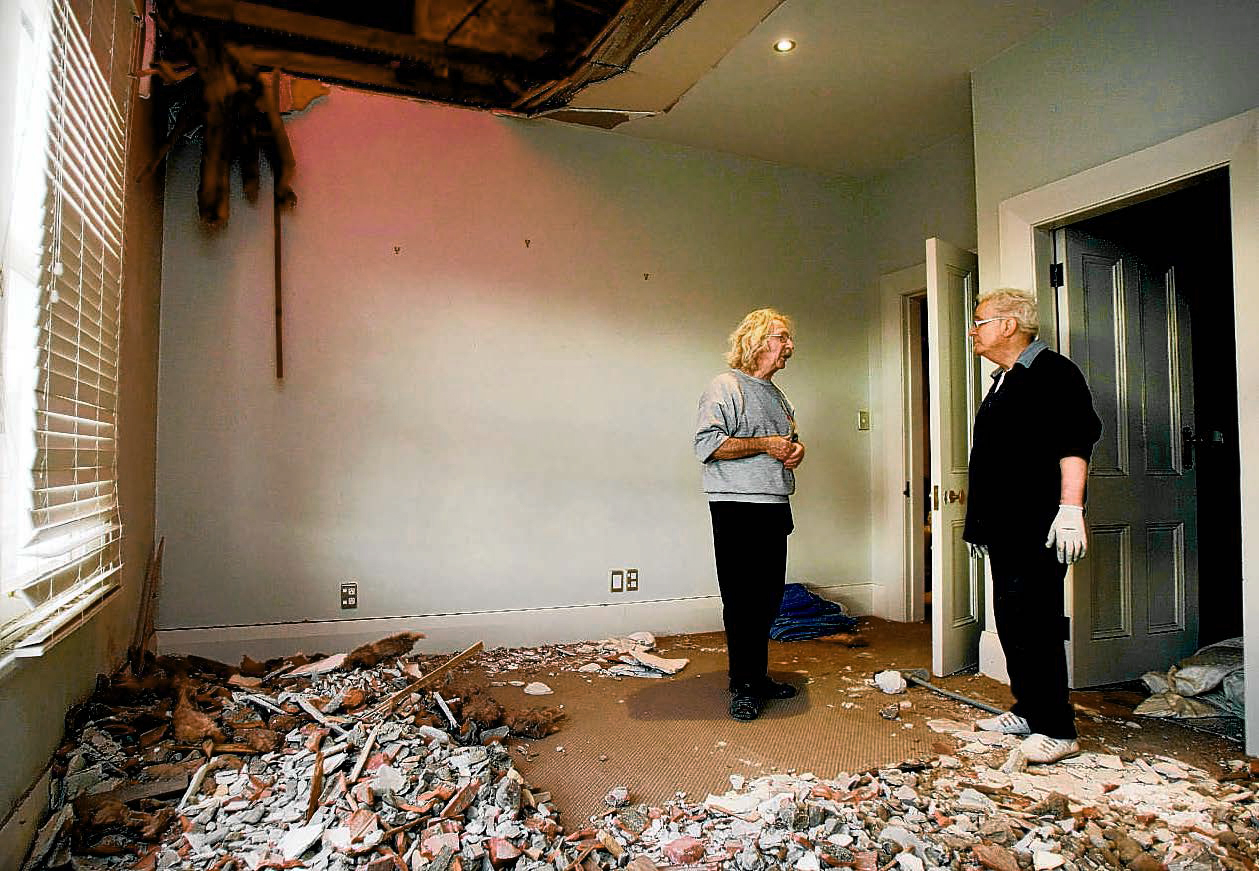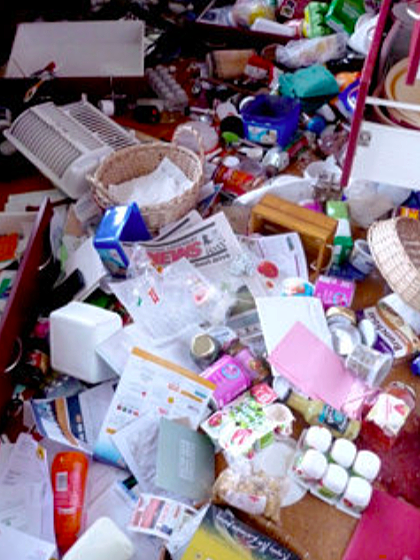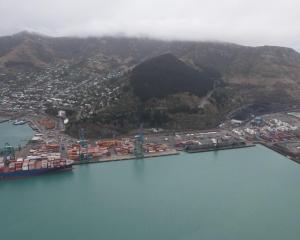
For Fraser the rebuilding process has been particularly challenging – his husband Kenneth McCaul was killed in a car crash in October.
The century-old two-storey weatherboard home has been restored to Kenneth McCaul’s exact specifications, though one vital element will always be missing.
Owen Fraser happily details how the Kaiapoi property was refurbished after the quake though a decade later the project is also tinged with sadness.

The Australian was killed when the car he was driving was t-boned by a vehicle being pursued by police in Fendalton early on October 22 last year, as he headed to work at Christchurch Hospital.
Jayden Richard Breakwell, then aged 18, was jailed for two years and eight months last December for manslaughter and reckless driving causing injury.
“I’ve just painted the inside of all the window frames upstairs,” Fraser explains before he revisits the September, 2010 earthquake.
All three chimneys collapsed, one into the bedroom the couple had shared until shortly before the earthquake.
“If we’d been in that bedroom we would have been killed because the chimney landed on the bed.
“We decided to move to the front bedroom a month before, we must have got a signal from somebody,” he said.

“We looked everywhere for a house we liked, we saw this one and visualised what we could do with it,” Fraser said.
“The last people that had it tried to modernise it, which didn’t really help the house. We’ve sort of taken it back to more to the style that it should be.
“Kenneth came up with some really good ideas. There are new drapes in the living area. We were choosing those when Kenneth was killed, I’ve done that since he’s gone. There’s other things he was going to do which I’ve done.”

“We got in really early because we knew there would be a shortage of scaffolding and all that sort of thing,” Fraser said.
“We actually put the scaffolding up before we heard from the insurance company. We rung them and said ‘‘you better hurry up and sort things out because we’ve already got the scaffolding up’.”
Fraser added he was impressed at how Kaiapoi had recovered in the aftermath of the 7.1 magnitude quake.
“It’s recovering a lot quicker than Christchurch. We lost about a third of the town to the red zone. A lot of houses were pulled down but it’s expanded since then.
“I’m pretty sure our recovery is going a lot quicker than Christchurch.
“One of the things they really should have got stuck into sooner was the cathedral. That’s really pulling things down with that sitting there.”
Meanwhile, Fraser is bracing to reflect on another poignant date on the calendar as the first anniversary of McCaul’s death approaches.
“I miss him heaps. Kenneth loved it here, he loved New Zealand.”
Historic lodge a quake survivor
Almost 10 years ago to the day, Simonetta Ferrari could have died.
An eight-tonne chimney came crashing through her ceiling, smashing on to the bed she was sleeping in – caused by the 7.1 magnitude quake that devastated parts of Canterbury.
“It missed me by less than a metre, hitting the end of the bed. It was very close,” she recalls.
“Afterwards, I couldn’t get out of the room, the door was jammed. Plaster and bricks were flying around us. I remember having a mouthful of plaster as I was trying to get out.”
Ferrari is the owner of the Gunyah Country Estate, near Glenroy, and was in bed with her husband at the time, William Cottrell.
Cottrell snapped an Achilles tendon as he was trying to escape from the bed, and was struck by a brick.

“I was up to my knees in brick and then the back of one leg got smashed.”
Cottrell said if he had not got out of bed as quickly as he did, he would have been killed.

“You are in such an adrenaline type mode to be able to deal with what’s happening.
“It took a long time and it’s only looking at the photos months after that suddenly you think oh gosh there was a chance I may not have been here anymore.”
The two-poster antique bed was completely destroyed by the weight of the chimney.

“I do think about it still now, I’ll never forget it. It has affected my life and it is quite hard to talk about sometimes.”
Ferrari was considerably lucky compared to a man in his 50s who suffered serious injuries when a chimney fell on his taxi in Manchester St, Christchurch.
In the February 22, 2011, earthquake, falling bricks and masonry killed 11 people in Christchurch.
Ferrari said she can remember the confusion when the earthquake first struck.
“I’ve never been in an earthquake before so I had no idea that’s what it was. My brain thought oh there is a lot of noise and I was being shunted back and forth on the bed.
“I remember thinking what is it? It can’t be an earthquake, and then I thought oh s**t it is an earthquake.”
Gunyah was partially back up and running in a few months. Repairs on the building were finished two years after the quake.

Bexley’s Pacific Park was devastated in the 2010 quake, liquefaction causing irreparable damage to the relatively new subdivision.
Marilyn Pratt still occasionally wanders down memory lane, what was Seabreeze Close in Bexley’s doomed and now dormant Pacific Park.
One of the most distressing moments of the grandmother’s life took place inside No. 29 in the early hours of September 4, 2010, though she still has a soft spot for the fractured land that once housed her “forever home.”
“It was my home for retirement. I was there for five years and I still miss it.
“It was a lovely setting and it was a really good neighbourhood. We’d all go out for a meal every six weeks to the Woolston Club . . . little things like that, you don’t normally get,” Pratt said.
Now secure in the Prestons Park development in Marshland, with her daughter Vanessa and granddaughter Lucy, Pratt sometimes meanders around the swampland subdivision now reclaimed by wildlife.
Her neighbours dispersed far and wide, including the bloke who checked on the family soon after the quake struck in the pitch black.
“He banged on the door and warned us about the liquefaction. He said don’t come past the step,” Pratt recalled.
“I see the odd one (neighbour) from time to time but he’s absolutely disappeared, we don’t know what’s happened to him.”

“We bought house in Queenspark, we’d only been in that a few weeks and then the next earthquake hit,” she said.
“We had to live in it for the year. Lucy calls it the ‘broken house’, she can just remember the broken house where the rain came in.
“There was a drip over the dining room table. We had to go right through that winter, we didn’t have a toilet or power for a long time.
“By the time we went through all the insurance and the government stuff, all the paperwork stuff was horrendous. I’d never have got through it all without Vanessa.
“When we went to sign up for our house at Kaiapoi we actually went three times. They’d change the policy the night before or the day before. It was terrible,” she said.
While Pratt has come to terms with the financial implications of her move to Pacific Park, Lucy, now aged 10, is still affected by the earthquakes and aftershocks.
“She’s got quite a lot of anxiety with noise. If we’re at a mall or somewhere and you go into a toilet and somebody turns the hand dryer on she put her hands over her ears or she has to get out.”
Fortunately gymnastics has proved therapeutic.
“That’s her life, she trains four hours at a time (in Aranui) so we moved from Kaiapoi to closer to town,” Pratt said.
“We’ve relocated lots, hopefully we’re stable this time.”
- The magnitude 7.1 earthquake was the largest earthquake to affect a major urban area since the 1931 Hawke’s Bay earthquake. It was a relatively shallow earthquake – about 10km below the surface of the Canterbury Plains. During the strong shaking, the ground near the epicentre moved at up to 1.25 times the acceleration due to gravity. The earthquake was accompanied by a large surface rupture.
- The quake was the first in New Zealand in which social media were used to share information. GeoNet earthquake reports were sent out using both Twitter and Facebook after each major aftershock.
- The worst damage was suffered by older (mainly pre-1940s) buildings constructed of brick and masonry, and lacking adequate reinforcement. Some walls crumbled, with bricks cascading onto the streets. Brick chimneys toppled through tile roofs. A fault rupture occurred along a previously unknown fault line, which was named the Greendale Fault. Movement along the fault broke the surface, creating a fault trace extending for 30km west from Rolleston.
Defiant locals gathered at broken bar
The Valley Inn regulars reacted to the September 2010 earthquake with a show of defiance that left an insurance assessor dismayed, and publican Dean Calvert unfazed.

Calvert was on the scene shortly after the quake struck at 4.35am and by daybreak locals had already assembled amid the wreckage.
“We were sitting around the well having a beer, the whole time locals were coming and going, it was strange times,” Calvert remembered.
“The insurance guy came down and goes ‘What are you doing? You need these people out of here’.
“I told him they’re having their last beer in the pub. This is part of their lounge for all these people. We’re not going to be reopening are we?”
But Calvert, who took over the lease the day his parents George and Janet bought the building in 2004, pessimism was eventually misplaced.

“We would have been on top of it but we had to recheck the ground (after February).
“We didn’t start building until May but the local tradies all offered to work. It was all hands on deck just to get the pub back.”
Then mayor of Christchurch Bob Parker reopened the bar 23 days after the quake’s first anniversary, with the brick-lined well the only remnants from the original built in 1877.
While the Valley Inn was quickly re-established, Calvert laments the same cannot be said for the central city.
“I don’t know how it’s taken so long. You look at Japan when they had that tsunami and earthquake,” he said.
“They were probably rebuilt in two or three years at the most. And we’re still arguing with bloody politics and bits and pieces.
“Everyone’s p****d around too much organising stuff which they can’t organise.
“We were lucky. The earthquake happened on the 4th of September and the bulldozer went through on the 10th.
“We were lucky we got on to it so quickly. Looking at some of the sites around town it’s a bit of shame that people haven’t organised things a bit better.”
Calvert received the permit to rebuild the day before the February 22, 2011, earthquake and never had any second thoughts in the following days.
“It was like a meeting place for the locals, it needed to be rebuilt. The local church did a BYO pub on Fridays for a while. They knew the Valley was a meeting place for Heathcote.
“Everyone used to go there and talk to their mates, some had been there 50 years.”

Dave Fitzjohn and his family were almost as close as you can get to the epicentre of the earthquake.
Their property in Greendale is near to Charing Cross where experts say the quake was centered.
“You feel like you’re on a fast train that’s gone completely out of control, the whole house was rattling,” said Fitzjohn.
“One thing I really remember was I woke up and said: ‘Earthquake,’ and my wife just turned to me and said: ‘Yes.’ It was one of those stupid married conversations.”
It was impossible to move at all, Fitzjohn said, but his wife April did not realise this and ended up being thrown into a cupboard.
It was a wardrobe type cupboard, she was trying to get to their teenage daughter Jessie.
“She hardly remembered being thrown into it but the cupboard door was completely munted.
“With her shoulder being black and bruised and the door pushed in, it all sort of came back. I think it was all that adrenaline at the time.”
Fitzjohn said once it was safe enough, he moved down to Jessie’s room.
“She was quite amusing in a way because when I got to the room she was shouting am I supposed to be under the bed or standing under a doorway?”
To this day, the Fitzjohn’s cannot figure out how Jessie managed to find her way out of her bedroom.
“Her room was completely full of stuff, she must have climbed up and over it and somehow pulled the door open enough and got down into the passageway.
“That night we could not actually get her back into her bedroom. We couldn’t open the door. God knows how she got out, it must have just been adrenaline.”

“As it got lighter we saw more bits of the house that were missing. Jessie said hang on the chimney is not there.
“Then, we had a huge water tank, it was like oh the water tank’s gone. It was quite freaky.”
Fitzjohn said they were told the house had moved between 10-30cm off its foundations.
The family had also just got a new puppy which was sleeping in a crate in their study at the time of the quake.
“The study was completely full of books that had come down, draws and all sorts. It probably took about 15 minutes to extricate this puppy.
“It’s lucky he was in a crate, I can’t imagine if he had just been lying there. It came out wagging its tail as if it was just a cool game.”
- Chris Barclay and Devon Bolger























